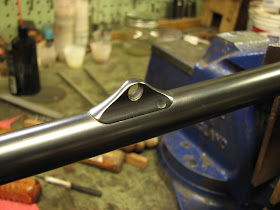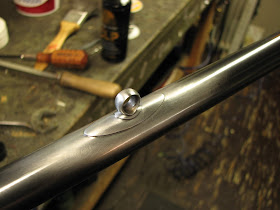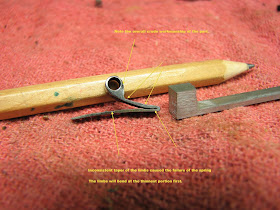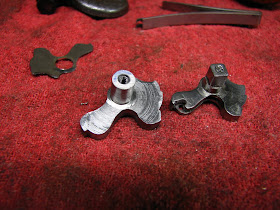There are so many myths and so much just plain bullshit in the gun world and it simply refuses to go away. So in the interest of disposing of some of it, I'm going to address some of those myths and some of that BS here. There is surely enough to make this a regular series, to say nothing of the brand-specific BS.
I'll start the list with my personal favorite.
"Restoration":
Everybody
with a buffing wheel, a Dremel tool and a Brownell's catalog thinks they do it. The ones
that ACTUALLY do it own neither a buffing wheel nor a Dremel tool and I, personally, rarely (almost never) order anything from Brownell's.
Possibly the most misused word in all of the gun world. If you restore
Rugers, the above does not apply.
"Mint Condition":
The second and third most misused words in the gun world. I prefer to use the dictionary definition versus the gun dealer's/seller's definition, which apparently allows for repairs, refinishing and other assorted deviations from the actual meaning of the phrase.
"As Far As I Know...":
The gun dealer's/seller's "get out of jail free" phrase. Typically used thusly: "As far as I know, those 18-inch barrels are original, probably rare", or, "As far as I know, it's a real A1 Parker", or the ever popular "As far as I know, it's all original". If you hear this phrase, beware. What it really means (usually) is "I do know but I'd rather make the sale".
"I Had a Local Shop/Guy Do It":
This is a common answer to the question: "Who the #$%^&* did this?!!"
"Hand Rubbed Finish":
This DOES NOT mean slathering Tru-Oil (or whatever) on a stock with your hand like a preschooler fingerpainting. "Hand rubbed" means the same thing in wood finishing as it means when referring to a paint job on a car. It means that each coat and the final coat is polished, by hand and using blocks and appropriate abrasives, in order to level the finish between coats and impart the chosen level of gloss on the final coat. A hand rubbed finish can be brushed on, sprayed on, mopped on, dipped, it doesn't really matter. It can be oil, lacquer, varnish, paint, shellac, etc. What matters is what is done between applications and after the final application.
"Seven Pin Sidelock":
This utterly meaningless term is a favorite of advert copy writers for Turkish gun companies and self-styled "experts" on all things doublegun. The number of exposed pins in a sidelock gun's lockplate have absolutely no correlation to the quality of the gun, period. Here is a short list of some of the best guns made in the world and the number of visible pins in their locks.
- Fabbri Over/Under, either 0 or 6
- Boss Over/Under, 6
- Fratelli Rizzini Over/Under, 1
- Fratelli Rizzini R1 SLE, 0-4
- Purdey Over/Under, 8
- Purdey Beesley SLE, 8
Think your Turkish side by side is a "best" because it has "seven pin" locks? It's not. The number of pins has only to do with the design of the lockwork, nothing more.
"High" and "Low" Brass Shells:
The height of the brass base of a shotshell has zero correlation to the chamber pressure, at all, period.
Shotshell pressure depends upon variables like hull internal volume and powder burn rate, not the height of the exposed brass. Remember Active shotshells? They had NO brass.
"Light Target Loads":
Most big-box target loads are only light in the recoil department. Many of them generate pressures of 11-12 KPSI. Remember, chamber pressure and recoil have no correlation. The next time you think, "It's OK, I'll just use light target loads", maybe reconsider and use shells for which your gun is proofed.
Measuring Pull Length:
Common "wisdom" has the shooter put the butt into the crook of their arm (at the elbow) and determine their "proper" pull length by noting where their trigger-finger lands. This is total nonsense, unless you actually shoot the gun that way. What you want is about an inch to an inch and a half between your thumb knuckle and the tip of your nose when the gun is properly mounted. Better to err on the long side as too short will make you lift your head. And no, a fourteen and a half inch pull length is not "really long" unless you're a member of the Lollipop Guild or you have arms like T-Rex.
"Relaxing Springs":
A spring's lifespan is measured in the number of cycles it will perform and the number of cycles is determined by its design, the choice and quality of the material used and the quality of its manufacture. It's funny that everybody worries about "relaxing" the mainsprings for storage but no one gives a thought to the ejector mainsprings, which are always compressed unless the ejectors are tripped. In actual use, a spring is never really "relaxed" since they are always installed with a considerable amount of preload. So in reality, if you're the type to always drop the hammers for storage, you're actually "using up" the finite number of cycles that make up the spring's lifespan. Don't worry about the springs and relax yourself.
"Water Table":
I have no idea where this idiotic term came from. They're either action flats or frame flats, the water table is under your house, where your well is drilled into. Nobody has a problem calling the barrel flats by their proper and sensible name. Maybe we should start calling them the "lawn", since they are above the "water table".
"Rabbit Ears":
They're hammers. Don't sound like an illiterate moonshiner.
"Sidekicks":
This is one that makes my ears bleed. Unless your parents are brother and sister, please don't refer to sidelocks as "sidekicks".
"Scattergun":
Oh Jeez.
Next time, maybe some brand-specific mythology.























































